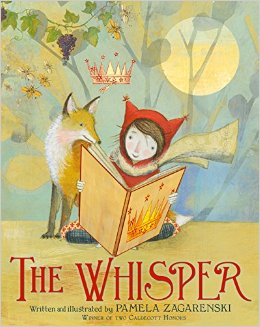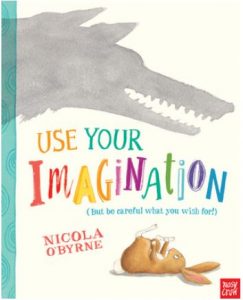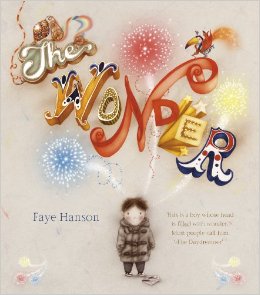Imagination
Kathleen Crawford-McKinney and Jean Schroeder
In happy hours, when the imagination
Wakes like a wind at midnight, and the soul
Trembles in all its leaves, it is a joy
To be uplifted on its wings and listen
To the prophetic voices in the air
That call us onward.
~ Longefllow

The Whisper, written & illustrated by Pamela Zagarenski
Kathleen:
This story is about a little girl’s love for stories. Waiting for the end of the school day, she notices a storybook on a high shelf. I suspect that something mysterious is going to happen because the book is high on the shelf. Her teacher loans her the book and on her way home the words fall out. The girl is saddened to make this discovery as she begins reading.
Jean:
I wonder why she just noticed the book at the end of that day? Did the book magically appear or had it been there all along? This certainly adds to the mystery.
Kathleen:
When I got to the page where the words fall out of the book, I spent a long time trying to make sense of the jumbled words and didn’t want to leave this page until I found clues to how the story might unfold.
Jean:
There is a fox following her, scooping up the words in his net. I kept trying to find words in the jumble. One thing that I notice is that “love” and “magic” are the escaping words closest to the storybook and the last words to fall from the book. The first words into the fox’s net are “Once upon a time.” I also spent a long time looking for words–a great way to invite a reader into the story.
Kathleen:
The girl is so disappointed when she realizes there are no words in the storybook, rejecting the book because of the lack of words. But through the wind, she hears a “whisper” of encouragement to use her imagination. In your imagination, “there are never any rules, rights, or wrongs in imagining–imagining just is.” Using her imagination is not easy, as demonstrated in the text. The author guides the girl through this roadblock by posing thoughtful questions. The girl tries to expand the picture by talking about them. As the pages turn, the girl’s imagination grows and she jumps into the storybook to create new scenarios.
Jean:
SO important for teaching–we have to ask thought-provoking questions. And these questions have to grow in depth like the girl’s imagination grows as she turns the pages of this book, becoming more able to express what she thinks.
The thing that bothers me about the book is that the girl would look at these pictures–and they are acting as story starters. I discourage teachers from using story starters because children become dependent on them. This concern eased after the girl begins to create her own. They seem to give the girl a boost in her ability to use her imagination to tell stories.
Kathleen:
I didn’t see them as story starters. I saw them as immature creativity at the beginning–her own undeveloped thoughts that once she stretches her imagination result in more ideas falling out of her as the words fall out of the book. Imagination takes practice. The more you stretch your mind, the more often new ideas can be brought into the world.
Jean:
And the more sophisticated your ideas are. By developing her imagination, the girl’s confidence grows. As her confidence grows, she begins to realize the power an author has when they write.
This is a slow book. By this I mean you have to read slowly to find and absorb everything on a page. For example, start at the beginning, the very beginning. The story begins with the end pages. Find and follow the crown throughout the book.
Kathleen:
Other things can be followed–not just this book, but in all of Zagarnski’s books. There are teacups, honey bees, and teapots. I primarily looked for her grandmother’s immigration papers from Lithuania when she immigrated to America. Zagarnski’s website is fascinating and full of fun information about her work.
The end pages are an important aspect of this story–especially at the end of the book. The girl writes a variant of Aesop’s fable “sour grapes.” That she takes the story and makes it her own is another indication of the power of the author’s use of imagination. I suggest readers take in the illustrations from cover to cover–not just briefly check them out. Truly absorb them and think about their meaning and what they say about the story. Pictures whisper as well as the wind.

Use your Imagination (But be careful what you wish for!) by Nicola O’Bryne
Jean:
On the very first page of this book, the shadow of a wolf casts over a rabbit lying in a bored state, “wishing something would happen,” and giving the reader a sense of foreboding. On the very next page, the author lightens the mood when the wolf refers to himself as the librarian and offers to help the rabbit out of boredom by creating a story. Librarians have a reputation of being strict authority figures who tell us to be quiet. You can’t quite shake that untrustworthy feeling. The illustration on this page adds to this unease with an evil glare and sharp teeth.
Kathleen:
Yes, the story line of Little Red Riding Hood has always intrigued me. This book employs the classic tale even to the extent of using the language, “What big ears you have!” and “What big eyes you have!” The response given by the wolf to these exclamation relates to better listening to stories and better reading of stories. The wolf lures you into the notion that he is a “good guy,” but the tongue hanging out of mouth tells a different story!
Jean:
The wolf clearly has ulterior motives beyond the rabbit’s story creation. He manipulates the rabbit’s thinking by rejecting all of ideas the rabbit suggests for the heroic characters, the storyline, and the costumes. The end result favors the wolf’s appetite.
Kathleen:
The wolf guides the rabbit to create a “once upon a time” story. He encourages the rabbit to “use your imagination.” But every time the rabbit suggests ideas for the story, the wolf leads the rabbit to the story of being eaten by the Big Bad Wolf. In the nick of time the rabbit realizes that if she uses her imagination, the villainous wolf could be taken out of the story and sent to the moon–the story the little rabbit wanted to write in the first place.
Jean:
I am reminded of the book My Duck by Tanya Lynch, in which the child is to write a story. Her first attempt is about a duck wearing shoes but the teacher rejects it. The girl’s second attempt is about a little girl with wings–also rejected. At least in that story, the teacher is not on the chase.
Kathleen:
That the rabbit changes the outcome of the typical Little Red Riding Hood plot highlights the importance of using imagination. As the author, it is within your control to take the story in whatever direction you choose.
Jean:
It’s almost like a melodrama where you want to shout, “Yay!” when the rabbit comes up with a good idea and, “Boo!” when the wolf leads the rabbit to say what the wolf wants.
Kathleen:
The format of this book is different in many aspects. I love the changes in font and size throughout the story to create emotion. For example, when the wolf chases the rabbit around the page, readers follow the chase in and out of the trees by using the path of words through the woods.
Jean:
The back cover has a hole in it with the actual last line on the back cover, “You never know where your imagination might lead you!” It does away with the notion of “the end.”
Kathleen:
The page that opens up to poster size is unique. I thought my book was broken! It turns out you just have to turn the page and it grows to a giant size–a demonstration of imaginative thinking just as the rabbit’s imagination is not stifled and negated by the Big Bad Wolf.
Jean:
It seems like we pretty much agree.
We designated the wolf as a “he” and the Rabbit as a “she.”

The Wonder by Faye Hanson
Kathleen:
The story is about a boy whose imagination brightens his day as he makes his way to school. He encounters the park keeper, the bus driver, the crossing guard, his homeroom teacher, and his science teacher, who each tell him in their own ways to pay attention. That is until his art teacher provides the space for his imagination to come alive in a positive productive manner. Thinking about his day, the boy takes us back through the morning into a magical world that he has created. The story ends with a glimpse into the future and the boy’s sculpture is displayed in a museum with crowds of people waiting to see his work.
Jean:
We both questioned whether we would like this book. It didn’t draw me in from the get-go. I wondered why there are seemingly two title pages–the first in black and white and the second in bright color on a brilliant blue background. I didn’t notice this until I read the book several times.
Kathleen:
The illustrations begin in sepia tones with a minimalist feeling but enough detail to make you question. The boy’s first encounter is with the park groundskeeper who chastises the boy for not keeping off the grass. While the boy doesn’t see the sign, he brings to life a bird in golden colors.
Jean:
Being interested in birds I wondered what kind of bird triggered such an exotic feathered friend.
Kathleen:
As he continues on his journey to school, the illustrations remain in sepia except when he wonders about something–the clouds, the crossing guard’s sign, the best playground ever, how the stars shine.
Jean:
Then the art teacher takes the proverbial lid off, which catches the boy off guard. His wondering goes blank, but only for a moment or two. Then the golden bird flies through his mind in even more detail than before. There seems to be a transition on the next double spread illustration with the bird leading the way. The sepia tones take on more solidity with miniature glimpses into a new world. I love that there is a sign indicating, “Don’t keep off the grass.”
Kathleen:
This is followed by four more double page spreads that revisit the boy’s travel to school that morning. The bus to school does not resemble a bus in the least, but instead as multiple modes of transportation with different animal characters throughout. The crossing guard page makes the reader feel as if entering Willie Wonka’s world “filled with imagination.” This world includes jellybeans, sprinkles, lollypops, and candy canes in bright vivid colors.
Jean:
Who are the advocates for this child? We have all experienced working with children who have vivid imaginations.
Kathleen:
Definitely his art teacher encourages imaginative thinking. Although there is no written text to confirm it, the boy’s mother is seen in the first illustration in a loving and caring pose as she helps him get ready for school.
Jean:
Something else I notice is the dedication, “To Mum–for believing in my daydreams.” That verifies the idea that the mother in the story is supportive.
Kathleen:
As we begin a new school year, I wonder how many of us provide the space to help our students open their minds and encourage imaginations in whatever content we teach. How do we reach out to invite our students into the world of learning and exploring?
